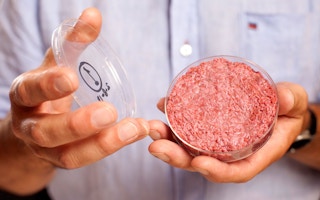The world’s first beef burger created from stem cells has a texture that’s closer to cake than steak.
The burger, fried in a public unveiling in London today, lacks the fattiness of regular meat and could be described as an “animal-protein cake,” according to Josh Schonwald, a Chicago-based author and one of two tasting volunteers.
The 5-ounce burger, which cost more than 250,000 euros ($332,000) to produce, was developed by Mark Post of Maastricht University with funding from Google co-founder Sergey Brin. Post is among scientists including those at Modern Meadow and New Harvest who are experimenting with ways to grow meat in labs as an alternative to raising livestock, which contributes 18 percent of greenhouse gas emissions and uses 30 percent of the world’s ice-free land, according to an Oxford University study.
“We are catering to beef eaters who want to eat beef in a sustainable way,” Post said at the event in London today. “This is a technology that can be transferred to other animals as long as they have stem cells in their skeletal muscle. So it can be transferred to animals like fish, chicken, and lamb.”
Schonwald, the author of a book called “The Taste of Tomorrow,” said the burger had a cake-like quality because of the lack of fat content and falls somewhere between a Boca veggie burger and a McDonald’s burger. Hanni Ruetzler, a food scientist and the other tasting volunteer, said the surface was crunchy and the inside was “very close to meat,” though lacking juiciness. Beet juice and saffron were added to the burger to enhance color.
Improving taste
Post said he’s still working on the twin challenges of improving taste and growing fat. Commercial production could begin in a decade or two, according to Post, whose work on cultured beef began in 2008.
The muscle stem cells, taken by harmless biopsy from living cows, are fed and nurtured so they multiply to create muscle tissue. The cells grow into strands, and 20,000 of them get combined to create one burger. One sample of cells is enough to create as much as 20,000 tons of meat in the lab, he said.
Post used fetal bovine serum, taken from the blood of calf fetuses, to multiply the cells after testing as many as 10 alternative nutrients that proved to be inferior. The cost of fetal bovine serum, the most expensive component of the process, is currently the main obstacle to mass production, said Neil Stephens, who studies developments in in-vitro meat research at Cardiff University’s Cesagen research center and School of Social Sciences.
Serum cost
Fetal bovine serum, also used to make vaccines, costs about $250 per liter, with as many as three fetuses required to produce each liter, according to a recent paper published in the journal Regenerative Medicine.
Any association with genetically modified foods is unwarranted, according to Post. “Cultured beef is normal beef,” he said. “It consists of cow cells.”
Lab-grown meat shouldn’t have any safety concerns and may actually be preferable to what’s available today, said Sandra Stringer, senior microbiologist at the Institute of Food Research in Norwich, England.
“We can see no reasons why this product would be less safe than conventional meat,” she said. “It is likely that it will be produced in sterile conditions and so could be much less prone to microbial contamination.”
‘More cultured’
Scientists growing lab steaks say alternatives are needed to avoid depleting too much of the earth’s resources as the world population increases and meat consumption grows. Cultured meat production uses as much as 60 percent less energy, resulting in up to 95 percent lower greenhouse gas emissions and 98 percent lower land use compared with conventional production in Europe, according to a study conducted by Oxford University and University of Amsterdam researchers and funded by New Harvest, a non-profit cultured meat research group.
In Columbia, Missouri, Andras Forgacs and his father Gabor are growing meat and leather using bioprinting, the 3-D assembly of tissues driven by computer-controlled processes.
“We’ve already been growing food with cultures to make beer, wine, yogurt,” the younger Forgacs said at a TED talk in Edinburgh in June. “It’s clean, efficient and humane. Perhaps we are ready for something literally and figuratively more cultured.”
It’s too early to know whether the public is ready to adopt meat that comes from the lab, though so far there hasn’t been much organized resistance from vegetarians or industrial producers. Acceptance of in-vitro fertilization could serve to gauge society’s response to cultured beef, according to Stephens of Cardiff University.
“What’s weirder?” he said. “Growing meat in a dish or growing people in a dish?”

















